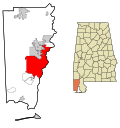George Levy House | |
 The George Levy House in 2008. | |
| Location | 107 Florence Place, Mobile, Alabama |
|---|---|
| Coordinates | 30°41′18″N88°5′22″W / 30.68833°N 88.08944°W |
| Area | 0.16 acres (0.065 ha) |
| Built | 1927 |
| Architectural style | Spanish Colonial Revival |
| MPS | Spanish Revival Residences in Mobile MPS |
| NRHP reference No. | 91000861 [1] |
| Added to NRHP | July 12, 1991 |
The George Levy House (also known as the Allan Bailey House) is a historic house located in Mobile, Alabama.






